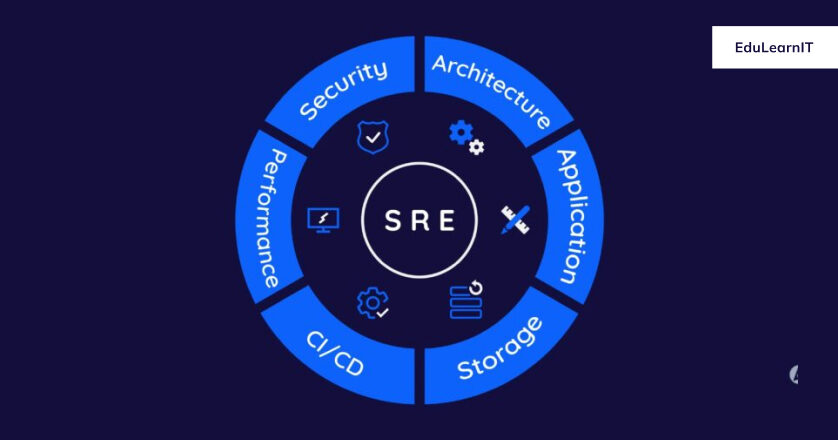EduLearnIT presents an Extensive and highly interactive “Site Reliability Engineering” Course by our industry expert with 14+ years of hands-on experience. SRE is what you get when you treat operations as if it’s a software problem. It aims to protect, provide for, and progress the software and systems with an ever-watchful eye on their availability, latency, performance, and capacity. Learn all the Site Reliability Engineerng concepts with hands-on practical examples. The course syllabus is designed by considering the current job market trends and industry requirements.
Add to Wishlist
SRE

Starting Course
1
Cloud Computing – AWS
- Cloud Computing – Introduction
- Why Cloud Computing?
- What is Cloud Computing?
- Service Models – Iaas, PaaS, SaaS
- Deployment Models – Public, Private, Hybrid, Community
- Major Cloud Providers
- Create an AWS account
- AWS Budget Setup
- Core Cloud Concepts
- AWS Regions & AZs
- AWS Services
- Security – IAM
- Compute Services – EC2
- VPC
- Provision EC2 in AWS Cloud
- Private vs Public vs Elastic IP
- Connect to your instance remotely
- Security Groups
- Launch your website
- Storage Services – EBS, EFS, S3
2
Shell Scripting (Self-Paced)
- Directory Navigation
- System Information
- Installing Packages
- Hardware Information
- User Information & Management
- File & Directory Commands
- Process Management
- File Permissions
- Networking
- Archives (TAR Files)
- Search
- SSH Logins
- File Transfers
- Disk Usage
3
Core Java (Self-Paced)
4
Python (Self-paced)
5
Site Reliability Engineering – Introduction
- What is Reliability of a system mean?
- What is Fault Tolerance?
- What id High Availability?
- What is Disaster Recovery
- SRE Vs DevOps (class SRE implements DevOps)
- SLIs, SLOs, SLAs, Error Budget
- Incident Management
- Change Management
- Roles and Responsibilities of SRE
6
Software Architectures
- What is Monolithic?
- What is Monolithic Architecture?
- Advantages & Disadvantages
- Monolithic Architecture – The Big problem
- Why & What Microservice?
- Characteristics of Microservice Architecture
- Advantages & Disadvantages
- Microservice vs. Monolithic
- Runtime Environment for MicroServices
7
Containerization – Docker, Kubernetes
- Containers in General
- Containers in IT
- Container Architecture
- Advantages
- Container Engines
- Docker – What and why?
- Introduction to Docker Hub
- Docker Installation
- Common Docker Operations
- Build docker images using Dockerfile
- Docker Volumes
- Install Docker-Compose
- Build and run images using ‘docker-compose.yaml’ file
- What is Container Orchestration Engine (COE)?
- COE Features
- Top 3 Container Orchestration
- What is Kubernetes?
- Why Kubernetes?
- Kubernetes Architecture
- AWS ECS (Elastic Container Service)
- AWS EKS (Elastic Kubernetes Service)
- Difference between ECS and EKS
- EKS Continued (EKS Cluster Setup)
- What is Pod?
- Pod Deployment
- Multi-container
- Pod Networking
- Inter-Pod & Intra-Pod Communication
- Pod Lifecycle
- Services – NodePort, ClusterIP, LoadBalancer
- ReplicaSet
- CloudWatch Container Insights
- Horizontal Pod AutoScaler (HPA)
- Cluster AutoScaler
8
Gaining Resilience and Reliability on AWS
- AWS Global, Regional, and Zonal Architecture Design
- Amazon's Global Storage Services – S3
- Running Resilient Databases On AWS – RDS and DynamoDB
- Fault Tolerant Computation On AWS – Lambda and EC2
- Core Resilience Principles for AWS – Load Balancing and Auto Scaling
- Using Kubernetes and EKS On AWS
9
Observability – Issue Debugging, Monitoring and Alerting
- Linux Monitoring
- Cloud Watch
- Prometheus and Grafana
- ELK (Elastic Search, Log Stash, Kibana)
10
Troubleshooting Performance Bottlenecks
- JMeter – Performance Testing tool
- Linux Performance
- Java Performance Tuning
- Database Performance
11
Eliminating toil and Automation
- Infrastructure Automation using Terraform
- Configuration Management using Ansible
- CI/CD Pipeline using Jenkins
- Automating Mundane tasks using Shell-Scripting and Python Scripting
Professionals who fall under any of the below categories:
Who wanted to transform themselves to Site Reliability Engineers in Cloud DevOps
Have hands-on experience in performance testing and Engineering skills and aspiring to become SRE professionals
Have hands-on experience as system administrators and DevOps skills and aspiring to become SRE professionals
· Developers who are looking forward to become DevOps and SRE Professional
·You will be able to start playing a role of SRE professional managing tasks for both Development and Operations functions.
You will be able to provide cloud architectural solutions indispensable to maintaining reliability of the system
You will be able to setup Monitoring solution and efficient Alerting Mechanism required for Production environment.
You will be able to perform infrastructure automation and other mundane tasks and eliminating toil
You will be able to get a very good view on new performance engineering trends – DevOps, cloud, resiliency and mobile.
You will be able to confidently talk to developers & architects on the performance issues, bottlenecks & recommendations
- Google Site Reliability Engineering
- SRE Books
- Azure SRE
https://docs.microsoft.com/en-us/azure/site-reliability-engineering/
SRE
